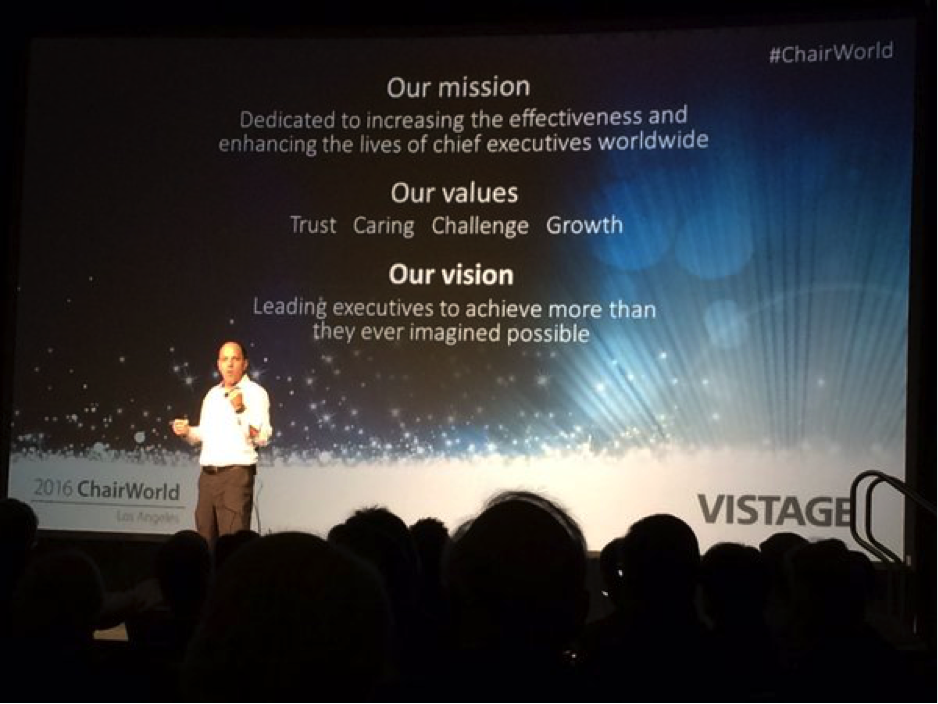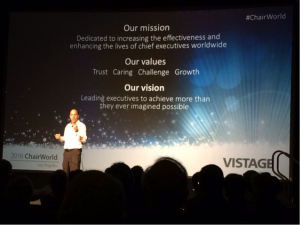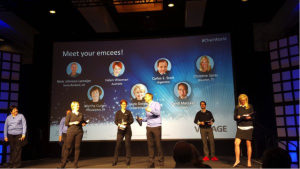Leadership Catalyst Blog

ChairWorld 2016 – Vistage Chairs Gathered in LA to “Sharpen the Saw” Together
Coaching, Human Capital, Leadership Development / 25.02.2016
What am I doing to continuously up my game? This question was top of mind as Vistage CEO Peer Advisory Board Facilitators from around the world gathered in Los Angeles earlier this month for ChairWorld 2016.
As a Vistage Chair and long time CEO coach, I frequently advise and assist my Vistage members and executive coaching clients as they work through stressful business challenges and weigh major decisions with company wide implications. I have the privilege of influencing the few that influence the many. For people like myself who are in the business of giving advice and facilitating issue resolution for a living, it can be easy to forget that even the best coaches and advisors in the field need to actively seek opportunities to up our game and build our knowledge banks so that we can bring more value to our clients and for our own good.
I appreciate that Vistage recognizes the importance of continuously “sharpening the saw” and provides opportunities such as ChairWorld for their professional chairs to do so. This is a key differentiator for Vistage as compared to many other chief executive peer group models.
Over 525 Vistage Chairs from all around the world came together for ChairWorld with the focus on how to improve as leaders and facilitators, learning from each other and fostering a stronger community. There were excellent keynote speakers, numerous breakout sessions to choose from, small-group workshops, formal and informal networking opportunities, and fun social events planned in the evenings.
The highlights of the conference for me included:
- Keynote address on leadership through adversity by polar explorer and top-rated Vistage speaker “Antarctic Mike” Pierce. Mike is the speaker that I have brought in to anchor my 4 Vistage Group meetings this week, and after listening to his talk at ChairWorld I know that my Vistage members are in for a treat.
- Breakout session on putting together a deal team when selling a business, led by legal and financial experts representing the buy and sell sides of transactions. A key question discussed was “how much lead time do you need for an exit” – a topic that I know to be relevant for some of my Vistage members.
- Dinner with the Vistage Colorado chairs – the Denver business climate is similar to Minneapolis in many ways. It was great to get to know the Colorado Vistage team better and to learn more about some of the innovative things that they are doing while also sharing the unique ways that the Minnesota team has been collaborating.
- Leading a “Wisdom Walk” session which paired chairs up to practice 1:1 coaching techniques so that the chairs could learn from each other
- Spending time with Lance Desceurez, the recipient of this year’s Vistage Pope Award which goes to the one chair out of 800 that best exemplifies our values and epitomizes the impact we as chairs strive for Lance is a good friend and mentor, and I know he will continue to help me raise my game as a chair this year.
One of my goals coming into ChairWorld was to look for opportunities around how I can improve my daily and monthly meetings with my members. Specifically, how I can inject more energy into my meetings and go deeper on issue processing to help my Vistage members and coaching clients understand the self-limiting beliefs that are holding them and their businesses back. I was also hoping to expand my Vistage community, increasing the number of chairs who I could pick up the phone and call as a friend, to talk through whatever the latest business issue or ideas we might have.
My experience at ChairWorld 2016 did not disappoint, and I am already applying my new learnings and building on new friendships.
So my question to all of my members and readers is: What are you doing to sharpen your saws? What is your version of Chairworld? Do you have a mentor or coach who is challenging you and helping you to become the best version of yourself. World class athletes have coaches to challenge them and keep them performing at the highest level – why shouldn’t you as a highly successful executive?
Read More >>How to talk to people about their potential for advancement.
All Blog Posts, Assessment, Coaching, High Potential Programs, Leadership Development, Motivation, Performance Management, Succession Planning, Talent Management / 31.03.2010

- Discussing Leadership Potential
Several organizations go through great lengths to identify their high potential leaders (HIPOs), and then seem to operate on a “don’t ask/don’t tell” policy. They fear that informing the HIPOs will cause them to coast or develop a sense of entitlement. Furthermore, they worry that those that are not deemed as HIPOs may feel they have no future and decide to leave or slack off. On the other hand, if you don’t inform the HIPOs, your brightest stars may assume their advancement opportunities with you are limited, and take that next headhunter call. Other organizations wanting to upgrade their talent are more than willing to tell them how bright their future will be with them, even if you are not.
One of the things that gets in the way of these discussions are the assumptions some organizations are making as they communicate potential including:
- Potential is a single trait—it’s not. It varies by management level and is multi-dimensional.
- You have it or you don’t. Not true, it is a continuum.
- It doesn’t change. Again, not true. A key component of potential is the person’s aspirations and interests, which can change with life circumstances and experience.
- Performance and potential are treated as independent measures (e.g.” 9 box grids”). From a motivational and retention perspective, there is tremendous power in letting performance “trump” potential, especially at lower management levels.
Thinking about potential as a dynamic, continuous, multi dimensional construct dramatically improves the quality of these discussions, particularly when done within the context of performance discussions. If you assume that performance trumps potential, the key message to everyone is that before you can be promoted to the next level, you need to become a top performer (e.g. top 20%) in your current role. That means the discussion for 70-80% of your people is focused on the “what’ and “how” of this year’s performance, celebrating their successes and figuring out how to fill their gaps. The main message for people who are not yet top performers but are seeking advancement is that they need to master their current role before focusing on the next one. While you can discuss their aspirations, interests, and career possibilities, the focus of the discussion with this group is on helping them achieve the level of performance required to be considered a top performer in your organization.
The discussion with top performers who are also seen as having high potential is the kind most bosses love to have. In this discussion you are celebrating their strong performance and signaling to them that they are highly valued and are seen by senior management as having the potential to move up in the organization. You are also exploring their aspirations (not everybody wants to move up these days) and talking about some of the most likely next roles and what they need to do to prepare for them.
The discussion with top performers who are not seen as having the potential to move up is the one that is most dreaded. Keep in mind, a large percentage of these people love what they are doing and have no interest in moving up. For these folks, the focus of the discussion is on celebrating their contributions, letting them know how much they are valued, and communicating that they have a bright future with the organization.
For those in this group with their hearts set on advancement, however, the conversation is a bit more delicate. After hearing more about the roles to which they aspire, the discussion needs to focus on how the success factors for those roles are different, and where they are likely to have some gaps. (E.g. Just because you are a great sales person doesn’t mean you will be a great sales manager.) For openers, you can talk about aspects of potential that are important in successfully advancing to all management levels such as conceptual problem solving, self-confidence, emotional control, and willingness to accept responsibility. As you move to senior leadership roles, other facets of potential such as vision, adaptability, willingness to take risks, and stress tolerance come into play. For additional ideas, there is an excellent book by Marshall Goldsmith entitled “What Got You Here Won’t Get You There” in which he lays out the 20 most frequent career derailers.
Is your high potential leadership program on the “Fast Track to Failure”?
All Blog Posts, High Potential Programs, Leadership Development, Succession Planning, Talent Management / 14.03.20102 comments
Most corporations are worrying about how to accelerate the development of successors for the expected exodus of “baby boomer” executives. While the impact of the financial crisis on most 401k plans may have delayed this exodus, the demographics haven’t changed, and within 5 to 10 years, a huge number of senior leaders will need to be replaced.
In working with dozens of companies on succession management and leadership acceleration programs, I have found that most are focusing almost exclusively on the organizational side of the equation—How to identify leaders with high potential (HIPOs) and then accelerate their readiness to step into the next role. Seldom, however, is enough attention paid to the individual side of the equation. The underlying assumption is that being tapped as a high potential is a huge benefit to the individual, and the individual’s aspirations as well as the significant downsides of being labeled a “HIPO” often are ignored.
Bottger and Barsoux of INSEAD spell out some of these potential hazards to HIPOs in their brief article entitled “Fast Track to Failure” in last month’s Conference Board Review. It is an open letter to newly anointed HIPOs, warning them of 4 inherent traps that can derail the most promising of careers, and well worth a quick read.
♦♦♦♦♦♦♦♦♦♦♦♦♦♦♦♦♦♦♦♦♦♦♦♦♦♦♦♦♦♦♦♦♦♦♦ LEADERSHIP CATALYST TIPS ♦♦♦♦♦♦♦♦♦♦♦♦♦♦♦♦♦♦♦♦♦♦♦♦♦♦♦♦♦♦♦♦♦♦♦
To make sure your high potential leadership program is on the fast track to success:
- Clearly define what is meant by “potential” vs. “performance” or “readiness”
- Accurately measure potential
- Make high performance a requisite for becoming and remaining a “HIPO”
- Avoid labeling people as “High Potential” too early
- Make sure you are having the right conversations with HIPOs so they know they are valued and to assure your expectations are in line with their aspirations.
- Accelerate their readiness through feedback, coaching, and action learning teams
I will expand on each of these in my future Monday morning blog posts.
♦♦♦♦♦♦♦♦♦♦♦♦♦♦♦♦♦♦♦♦♦♦♦♦♦♦♦♦♦♦♦♦♦♦♦♦♦♦♦♦♦♦♦♦♦♦♦♦♦♦♦♦♦♦♦♦♦♦♦♦♦♦♦♦♦♦♦♦♦♦♦♦♦♦♦♦♦♦♦♦♦♦♦♦♦♦♦♦♦♦♦♦♦♦♦♦♦♦
Read More >>


